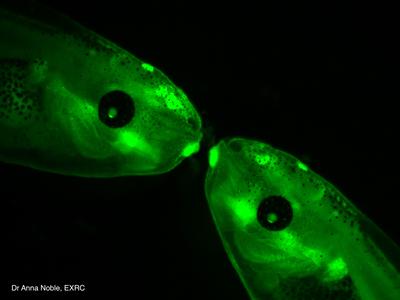Scientists use tadpoles to discover new genetic disease that delays child brain development

Scientists have discovered a new genetic disease, which causes some children’s brains to develop abnormally, resulting in delayed intellectual development and often early onset cataracts.
The majority of patients with the condition, which is so new it doesn’t have a name yet, were also microcephalic, a birth defect where a baby's head is smaller than expected when compared to babies of the same sex and age.
Researchers from the universities of Portsmouth and Southampton found that changes in a gene called coat protein complex 1 (COPB1) caused this rare genetic disease.
Now the variant has been identified, it will help clinicians come up with targeted interventions to help patients and their families, also opening the door to screening and prenatal diagnosis.
The research team, made up of frog geneticists, medical genomic research scientists and clinical geneticists, sequenced the DNA of affected patients and their family members, which identified COPB1 as the potential underlying cause of the disease. Using tadpoles to mimic the human gene variants, the tadpoles with the COPB1 gene changes had variably smaller brains than the control tadpoles and many of them had cataracts, just like the patients. This showed the link between the gene and disease very clearly.
The findings are published in the journal Genome Medicine.
Study co-author Diana Baralle, Professor of Genomic medicine and a clinical geneticist at the University of Southampton, said: “Next generation sequencing is transforming our ability to make new diagnoses and discover new causes for rare disorders. This story started with sisters I saw in clinic without a known underlying cause for their signs and symptoms. Looking closely at their genes, along with further functional molecular work and xenopus studies, we saw that this was a new previously undescribed syndrome. A diagnosis is so important to the family.”

Co-author Professor Matt Guille, who leads a laboratory in the Epigenetics and Developmental Biology research group at the University of Portsmouth, said: “This is the first time that the tadpole has been used in such a direct way to help solve a clinical challenge.
“In our initial experiments to test the link between a genetic variation and a disease we found to our surprise that by altering the DNA of tadpoles, four times out of five we could re-create the disease-related changes seen in human patients. This will allow us to support our colleagues in providing more timely, accurate diagnosis that patients and their families so desperately need.”
One in 17 people will suffer from a rare disease at some time in their lives. Most of these rare diseases have a genetic cause and often affect children, but proving which gene change causes a disease is a huge challenge.
Professor Guille said that previously, while studies connecting a gene and a disease were mainly performed in mice; several labs, including his own at the University of Portsmouth, have recently shown that experiments in tadpoles can also provide very strong evidence about the function of variant human genes. The process of re-creating some gene variants in tadpoles is straightforward and can be done in as little as three days.
Professor Guille added: “We now need to extend and improve our technology to make it applicable to the wider range of disease-related DNA changes provided to us by our clinical collaborators.
“If the clinical researchers find the information sufficiently useful, then we will continue to work together to scale up the pipeline of gene function analysis so it can be used to direct effective interventions for a significant number of patients.”
